"FourthEstate-which was in my mind Fiumana first, then The Workers’ Way-was one of my very first conceptions, it was the continued thought of a decade and I was not able to concretise it until after I had evolved my art with much, much work and with as much thought. But when thought and form merged in my conviction nothing held me back: not the scolding of family not the advice of friends not the backbiting of the less benevolent and other greater difficulties. It was such as I had wished it to be. The animated advance of a group of workers toward the bright source symbolizing in my mind the whole great family of the children of labor. Remaining as it is in composition, from which even today I would take nothing away the painting can be improved by making it better representative in the idea of strength. The painting is meant to be a glorification as well as others."
With these words, Giuseppe Pellizza da Volpedo (Volpedo, 1868 - 1907) described, in a 1904 letter, his best-known masterpiece, the Fourth Estate: since then the painting that glorifies the “great family of the sons of labor” has become a symbol, often misrepresented, much more often reread and reinterpreted, given its still extremely relevant meaning. It can almost be said that not a year goes by without a contemporary artist grappling with Pellizza’s challenging canvas now preserved at the Museo del Novecento in Milan, which is why the Fourth Estate still lives on today not only as the image and modern, topical masterpiece of one of the greatest artists in the history of art, but also through the dozens of reinterpretations that continually pick up its legacy by transmitting it to an ever-widening public with photographs, new paintings, murals, cartoons, comic strips, film stills and more. We therefore wanted to collect, in this article, a series of ten recent reinterpretations of the Fourth Estate to show how Pellizza da Volpedo’s message is still eloquent nearly one hundred and twenty years after the work was executed.
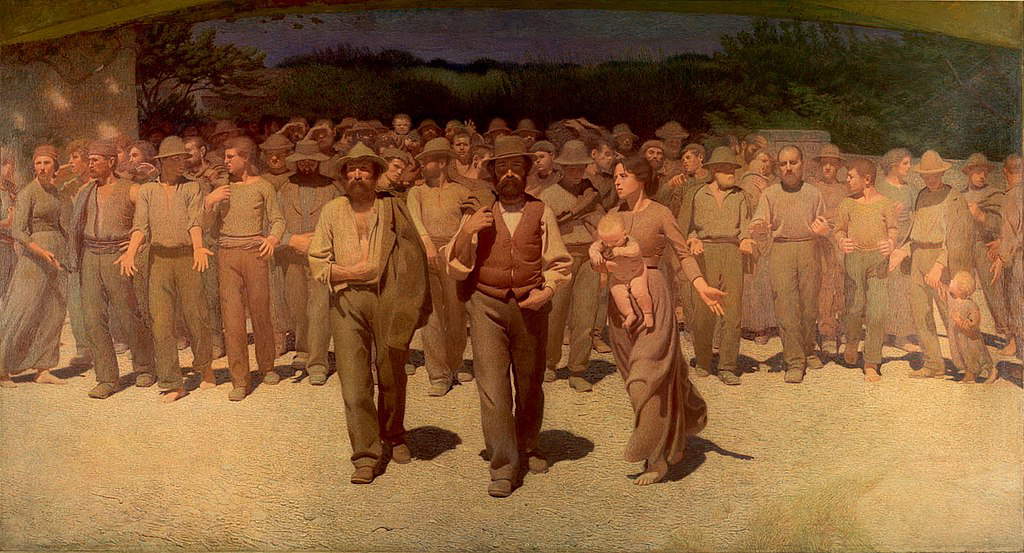 |
| Giuseppe Pellizza da Volpedo, The Fourth Estate (1898-1901; oil on canvas, 293 x 545 cm; Milan, Museo del Novecento) |
1. Things aren’t as bad as they could be by Liu Xiaodong
Liu Xiaodong (Liaoning, 1963) is one of the most highly regarded contemporary Chinese artists, and he is most famous for his work on migrants, moreover exhibited in 2016 in an exhibition on the theme at Palazzo Strozzi. In 2017, Xiaodong made a contemporary version of the Fourth Estate having migrants as its protagonists and giving it the title Things aren’t as bad as they could be ("Things aren’t as bad as they could be "): it was first exhibited at the Milan Triennale from April 28 to August 20 of that year, in an exhibition titled Terra inquieta (Restless Land), curated by Massimiliano Gioni and organized with the collaboration of the Trussardi Foundation. The title reflects the thought that migrants (and for the work, moreover, Xiaodong portrayed migrants housed in Milan’s reception centers), while being the “last” of contemporary society, at the same time are also the new base fighting for a better world, just as Pellizza’s workers did in the late 19th century.
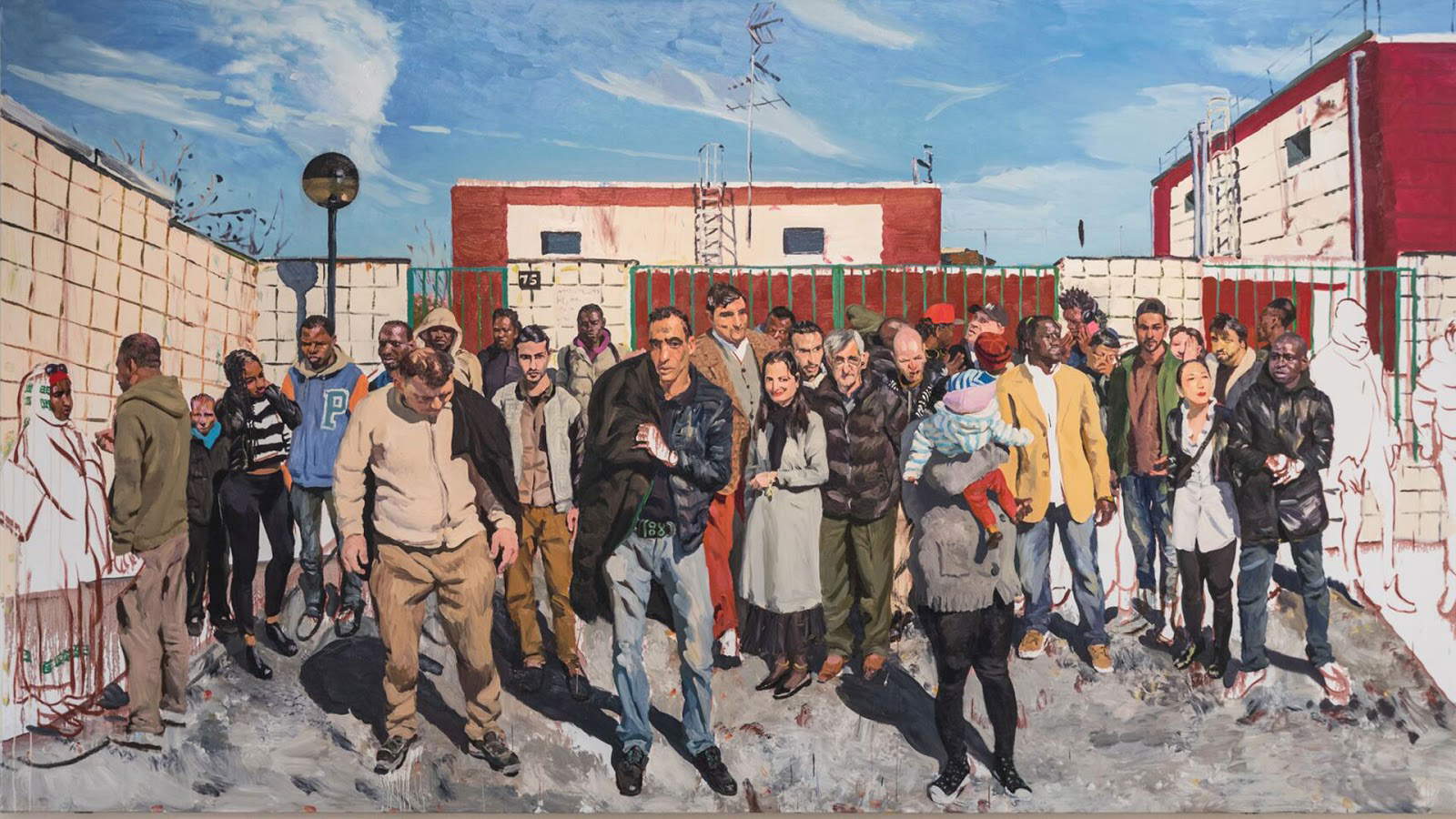 |
| Liu Xiaodong, Things aren’t as bad as they could be (2017; oil on canvas, 250 x 465 cm; Courtesy Liu Xiaodong and Massimo De Carlo) |
2. Hernán Chavar’s The Fifth State.
Argentine illustrator Hernán Chavar (Buenos Aires, 1979), in July 2018, made this illustration for an article published in Lettura de Il Corriere della Sera, entitled The Fifth State and signed by Maurizio Ferrara: a reflection on how society has changed, and in particular how the world of work has been transformed, in recent years. The last ones have thus become the precarious and those who do not enjoy adequate social protection: as a result, the front row of Chavar’s “fifth state” is occupied by a call center employee, a rider who delivers food for a multinational web company, and a disabled person in need of assistance. Further back, workers, students, nurses, office workers: a new labor family.
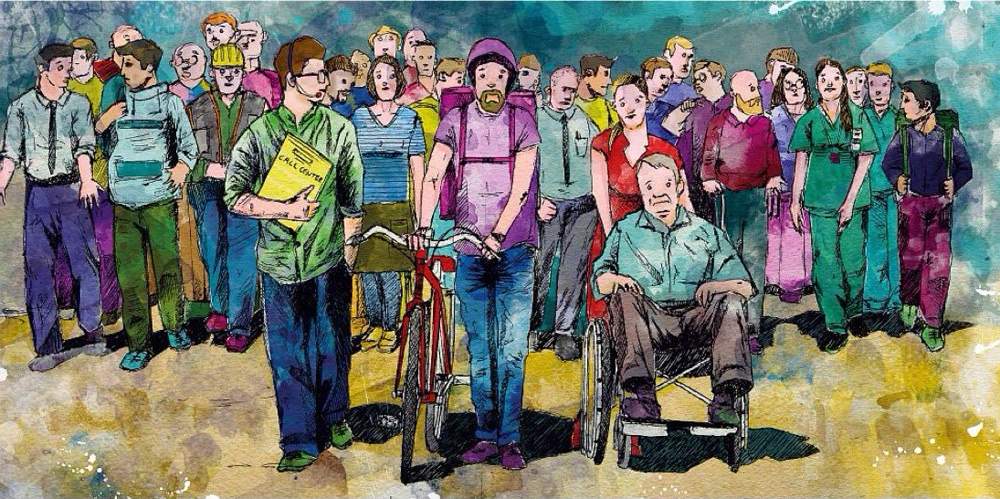 |
| The Fifth Estate by Hernán Chavar |
3. Vauro’s Fourth State of the Communist Cat.
In September 2009, cartoonist and cartoonist Vauro Senesi (Pistoia, 1955) launched a character, the Gattocomunista, in the pages of il Manifesto, which for a few months raged in his cartoons, also arousing resounding controversy, since just a few months earlier (on March 14) the cartoonist Pat Carra (Parma, 1954), in the same newspaper, had created an entirely similar cartoon as a parody of the adjective “cattocommunista” with which Berlusconi had labeled Dario Franceschini the day before, and she had not been credited with the motherhood of the idea. The controversy continued for some time, but in the meantime a number of cartoons came out in which Vauro’s starry-eyed cat Sylvester became the protagonist of various adventures, such as the one that sees him replicating himself in a bizarre reinterpretation of the Fourth Estate by “Pelizza [sic] da Gattedo.”
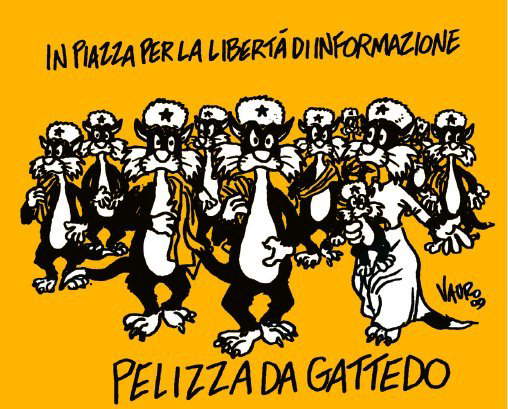 |
| Vauro’s “Pelizza da Gattedo” |
4. “Back People,” the 2017 L’Espresso cover.
Created by Dario Duluoz, the cover for L’Espresso on Sunday, November 19, 2017 is a bitter parody of the Fourth Estate, with its three protagonists, the mother and the two workers (who were real inhabitants of late 19th century Volpedo: the man in the center was named Giovanni Zarri and was a carpenter, the woman on his left was Teresa Bidone, the artist’s wife, and the other man is Giacomo Bidone, also a carpenter) turn their backs on the relative and go back, disappointed by a policy no longer attentive to their demands.
 |
| Dario Duluoz, Back People |
5. Tomoko Nagao’s Nippo-pop Fourth Estate.
Tomoko Nagao (Nagoya, 1976) is a contemporary pop artist and one of the leading names in Japanese pop art, known for her two-dimensional works in which the protagonists take the form of wispy little men with deep black eyes (and therefore similar to certain characters in the Japanese comic book tradition), and especially for her alienated contemporary kawaii reinterpretations of many works of the past, from Botticelli’s Venus to Hokusai’s Wave. In his Fourth Estate, workers wear Armani suits, eat Motta panettone, drink Campari, buy with Visa cards, travel with Alitalia and mount Pirelli tires on their cars. If, therefore, many artists have focused on the new last, Nagao has done the reverse: she wanted to have her say on the transformation that, according to her, the then last have experienced.
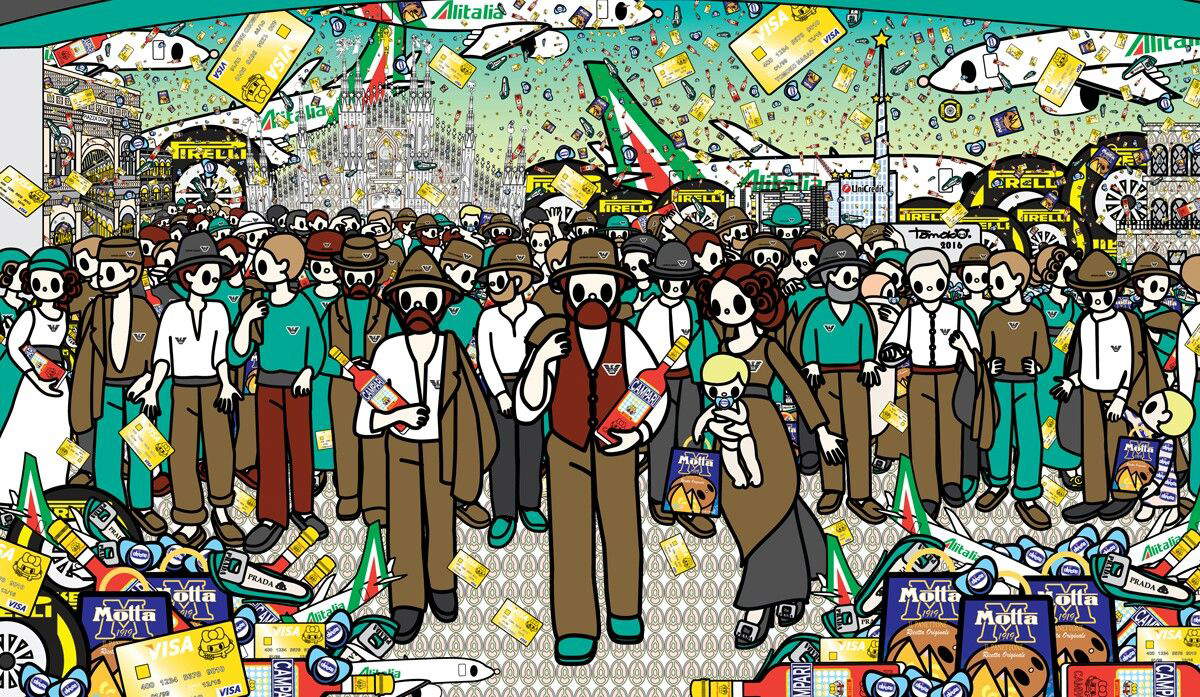 |
| Tomoko Nagao, The Fourth State (2015; silkscreen print, 70 x 100 cm) |
6. Ken Parker’s Strike.
Even the world of comics did not remain insensitive to The Fourth Estate: in 1984, almost one hundred years after the creation of Pellizza’s masterpiece, Sergio Bonelli Editore released album number 58 of Ken Parker, the character created in 1974 by Giancarlo Berardi and Ivo Milazzo, one of the most singular protagonists of western series. Modeled on the features of actor Robert Redford, Ken Parker was the protagonist of many adventures in late 19th-century America, and in issue #58 we see him on the cover at the center of a reinterpretation of The Fourth Estate, in a story in which he is hired as a worker in a textile factory and experiences the extremely harsh conditions of the workers of the time, with fourteen-hour days, miserable wages, and arrogant bosses, but also with the awareness that he is part of a united class determined to fight for its rights. Strike has recently been reprinted, but still with the original image on the cover.
 |
| The cover of the reprint of issue 58 of Ken Parker, with the original illustration by Giancarlo Berardi and Ivo Milazzo |
7. Settimio Benedusi’s The Fourth Estate.
Sugarcane pickers from a village in the Dominican Republic are the protagonists of the Fourth Estate by photographer Settimio Benedusi (Imperia, 1962), who revealed on his blog that he has always loved Pellizza’s work. “I had a shock, a crazy emotion,” Benedusi recounted, “I found myself, in a sort of cultural and temporal journey, inside that painting. I could live what I had always only seen from the outside. And understand deeper and much better the motivations behind that work of art.”
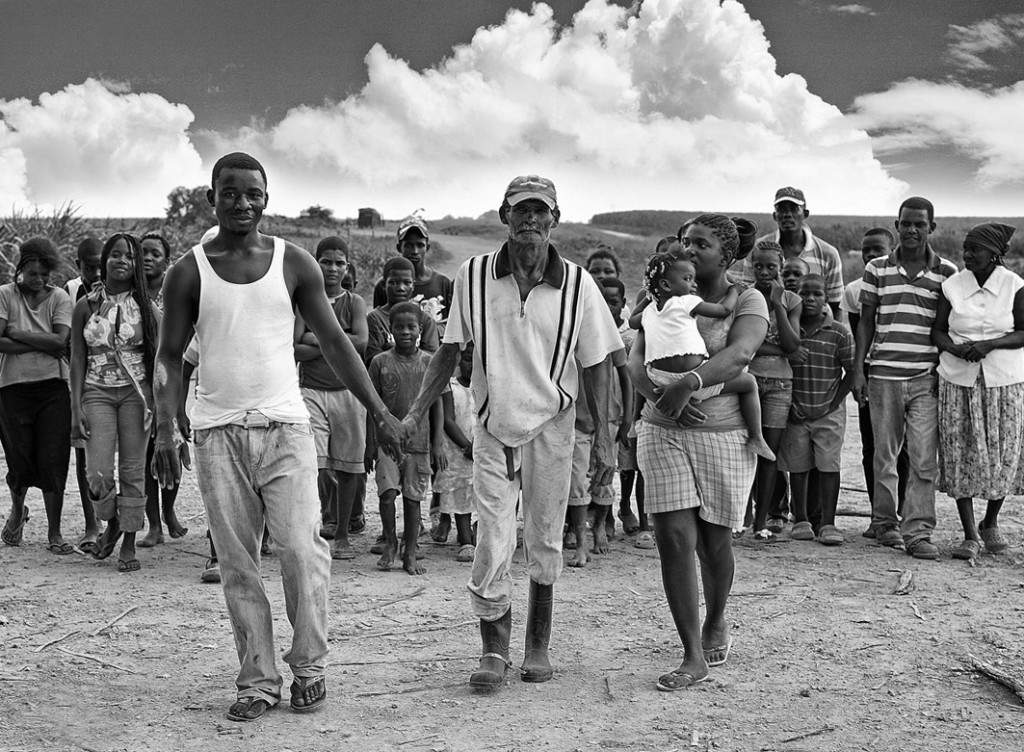 |
| The Fourth Estate by Settimio Benedusi (2012) |
8. The Fourth Estate of the Rich by Dolce&Gabbana.
A recent reinterpretation of the Fourth Estate by fashion designers Dolce&Gabbana has aroused strong controversy: in 2019 Milan, in Piazza del Duomo, a group of happy and smiling people advance compactly wearing garments signed by the famous fashion house. It is easy to imagine how the photograph has been interpreted by those who cannot afford the two Sicilian designers’ expensive garments: it has been read as a tacky hymn to ostentation. And while it can be debated to what extent Dolce&Gabbana have obliterated Pellizza’s message, it is nonetheless indisputable that the fascination exerted by his immortal masterpiece manages to be transversal.
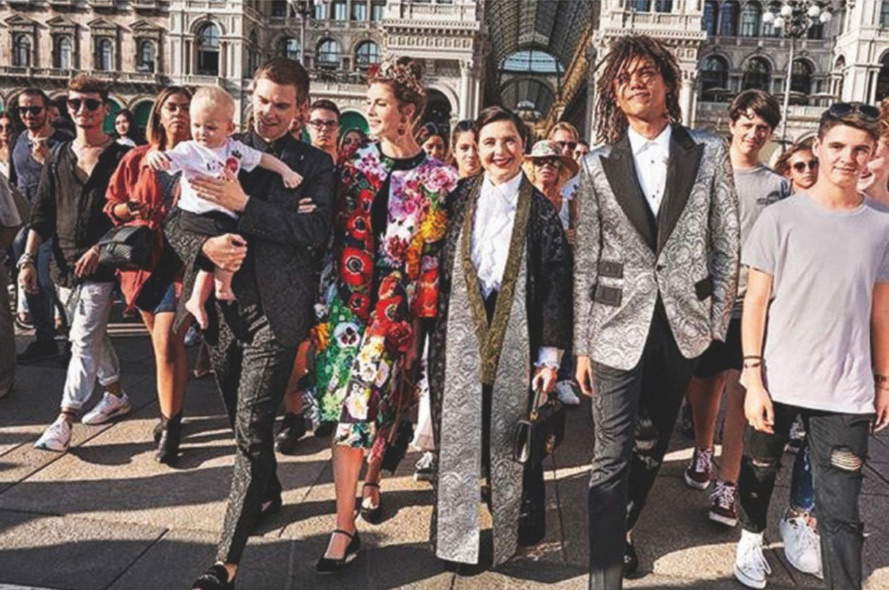 |
| The Fourth Estate by Dolce&Gabbana (2019) |
9. The all-female Fourth Estate of the “Caboto” school in Chiavari.
In 2018, students from the “Giovanni Caboto” institute in Chiavari came up with a special reinterpretation of the Fourth Estate by recreating it all-female, to reflect on the issue of violence against women. Thus, female workers, mothers, and children appear in the photograph, advancing toward the viewer to force him or her to become aware of one of the most heartfelt problems of contemporary society.
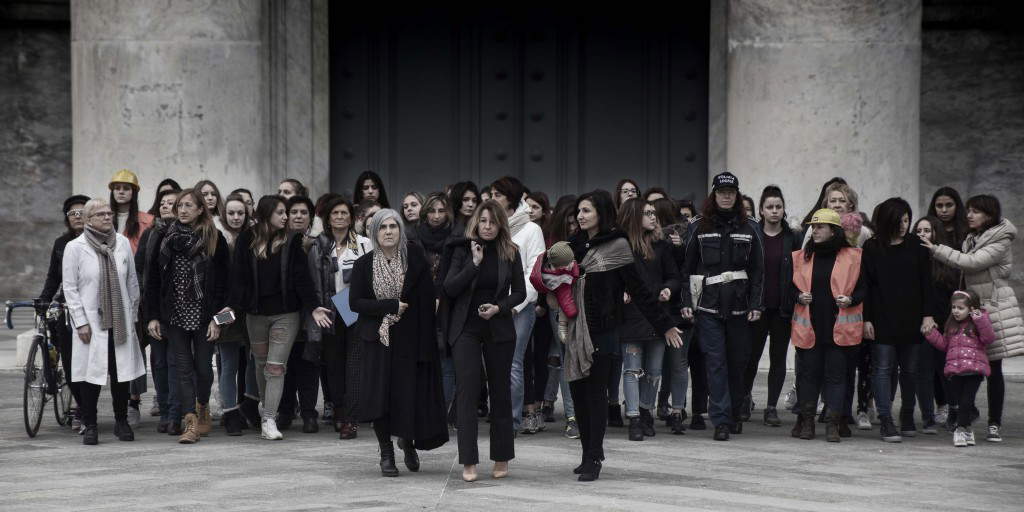 |
| The female Fourth Estate of Caboto students (2018) |
10. The Fourth Estate of Volpedo migrants.
In October 2015, the village of Volpedo, the hometown of Giuseppe Pellizza, welcomed some migrant families for the first time: they were two families from Nigeria who had left the country to escape the violence of terrorists and who, as they told the newspaper La Stampa, suffered hell before arriving in Italy, between torture in detention centers in Africa and the tremendous journey across the Mediterranean Sea. And shortly after their arrival they matured the idea of taking a photo that would portray them as the characters of the Fourth Estate, together with the inhabitants of Volpedo: and so they appear in Federica Castellana’s photograph published in La Stampa itself.
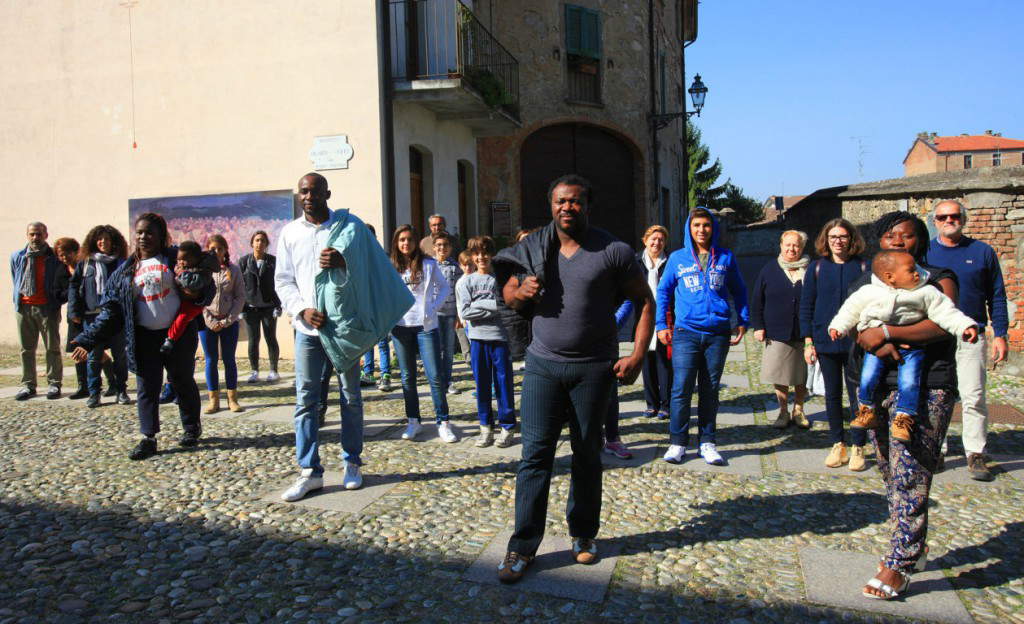 |
| The Fourth Estate of Volpedo migrants (2015) |
Warning: the translation into English of the original Italian article was created using automatic tools. We undertake to review all articles, but we do not guarantee the total absence of inaccuracies in the translation due to the program. You can find the original by clicking on the ITA button. If you find any mistake,please contact us.